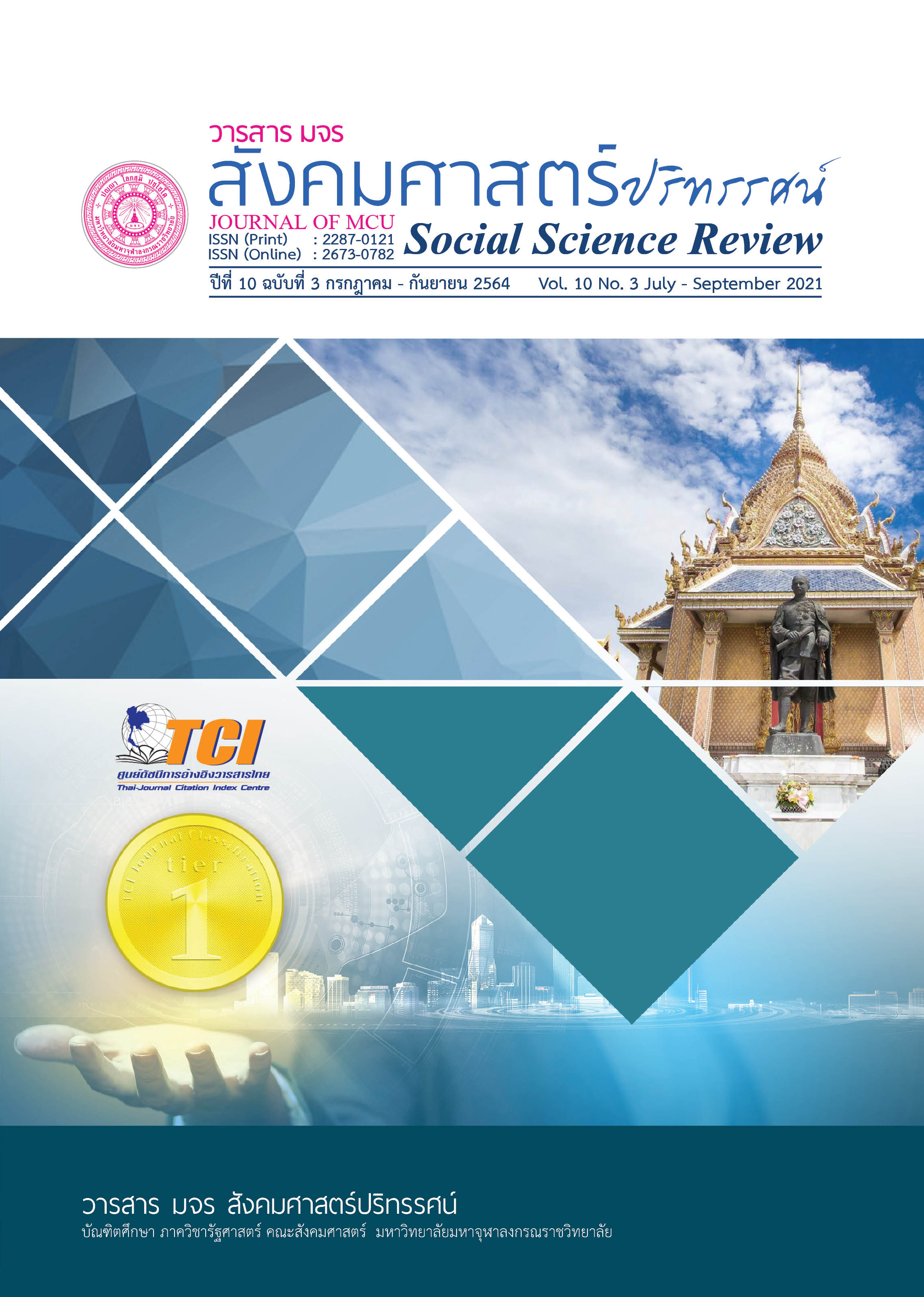การจัดการอาชีวศึกษาระบบทวิภาคีสู่ความเป็นเลิศในสถานศึกษา สังกัดอาชีวศึกษาจังหวัดฉะเชิงเทรา
คำสำคัญ:
การจัดการอาชีวศึกษาระบบทวิภาคี, ความเป็นเลิศ, อาชีวศึกษาจังหวัดฉะเชิงเทราบทคัดย่อ
บทความวิจัยนี้มีวัตถุประสงค์เพื่อ 1) ศึกษาระดับการจัดการอาชีวศึกษาระบบทวิภาคี
และ 2) ศึกษาเปรียบเทียบการจัดการอาชีวศึกษาระบบทวิภาคีสู่ความเป็นเลิศในสถานศึกษา การทำงาน เป็นการวิจัยเชิงปริมาณ กลุ่มตัวอย่าง ได้แก่ ครูในสถานศึกษาสังกัดอาชีวศึกษาจังหวัดฉะเชิงเทรา 181 คน โดยใช้เกณฑ์การกำหนดขนาดของกลุ่มตัวอย่างจากตารางสำเร็จรูปของเครจซี่และมอร์แกน และใช้วิธีการสุ่มตัวอย่างแบบหลายขั้นตอน เครื่องมือที่ใช้ในการเก็บรวบรวมข้อมูลเป็นแบบสอบถาม วิเคราะห์ข้อมูลด้วยค่าความถี่ ร้อยละ ค่าเฉลี่ย และส่วนเบี่ยงเบนมาตรฐาน ใช้สถิติทดสอบค่าเฉลี่ย t - test, F-test และการวิเคราะห์ความแปรปรวน
ผลการวิจัย พบว่า 1) ระดับการจัดการอาชีวศึกษาระบบทวิภาคีสู่ความเป็นเลิศในสถานศึกษา สังกัดอาชีวศึกษาจังหวัดฉะเชิงเทรา โดยภาพรวมอยู่ในระดับมาก ( = 4.46, S.D. = 0.54) เรียงลำดับจากด้านที่มีค่าเฉลี่ยสูงสุดไปต่ำสุด คือ ด้านคุณภาพผู้เรียนและผู้สำเร็จการศึกษา ด้านคุณภาพการบริหารจัดการ ด้านคุณภาพการจัดการเรียนการสอน และด้านคุณภาพความร่วมมือระหว่างสถานประกอบการกับสถานศึกษา 2) ผลการศึกษาเปรียบเทียบการจัดการอาชีวศึกษาระบบทวิภาคีสู่ความเป็นเลิศในสถานศึกษา สังกัดอาชีวศึกษาจังหวัดฉะเชิงเทรา จำแนกตามเพศ อายุ ระดับการศึกษา และประสบการณ์ในการทำงาน พบว่า เพศ อายุ ระดับการศึกษา และประสบการณ์ในการทำงานที่แตกต่างกัน มีความคิดเห็นต่อการจัดการอาชีวศึกษาระบบทวิภาคีสู่ความเป็นเลิศในสถานศึกษา สังกัดอาชีวศึกษาจังหวัดฉะเชิงเทรา โดยภาพรวมไม่แตกต่างกัน
เอกสารอ้างอิง
กาญจน์ เรืองมนตรี. (2557). การบริหารวิชาการและนวัตกรรมการจัดการเรียนรู้ (พิมพ์ครั้งที่ 2). มหาสารคาม: อภิชาติการพิมพ์.
จินตนา รวมชมรัตน์. (2558). รูปแบบการจัดการอาชีวศึกษาระบบทวิภาคีในวิทยาลัยอาชีวศึกษาสังกัดสำนักงานคณะกรรมการการอาชีวศึกษา (ดุษฎีนิพนธ์ปรัชญาดุษฎีบัณฑิตสาขาวิชาการบริหารเพื่อการพัฒนาการศึกษา). กาญจนบุรี: มหาวิทยาลัยราชภัฏกาญจนบุรี.
ณัทภพ แก้วสัมฤทธิ์. (2560). แนวทางการจัดการศึกษาอาชีวศึกษาระบบทวิภาคี เพื่อยกระดับคุณภาพแรงงานไทย หลักสูตรการป้องกันราชอาณาจักร รุ่นที่ 60 วิทยาลัยป้องกันราชอาณาจักร. สืบค้น 25 มิถุนายน 2562, จาก http://www.dsdw2016.dsdw.go.th/doc_pr/ndc_25602561/PDF/8400s/%E0%B8%A3%E0%B8%A7%E0%B8%A1.pdf
ณัฐวิทย์ มุงเมือง. (2560). การพัฒนาความร่วมมือการจัดการอาชีวศึกษาระบบทวิภาคีของวิทยาลัยการอาชีพในภาคเหนือตอนบน. วารสารพิฆเนศวร์สาร, 13(1), 133 – 146.
บุญลือ ทองเกตุแก้ว. (2559). การบริหารการจัดการอาชีวศึกษาระบบทวิภาคีของสถานศึกษา ในสถาบันการอาชีวศึกษาภาคกลาง 3. กรุงเทพฯ: สำนักงานปลัดกระทรวงศึกษาธิการ.
ประภาพรรณ ปรีวรรณ. (2559). รูปแบบความสัมพันธ์เชิงสาเหตุขององค์ประกอบที่ส่งผลต่อการพัฒนาการอาชีวศึกษาระบบทวิภาคี. วารสารบัณฑิตศึกษา มหาวิทยาลัยราชภัฏวไลยอลงกรณ์ ในพระบรมราชูปถัมภ์, 10(2), 201 – 214.
ยุพาวดี ศิริปีริดิ์. (2559). การจัดการอาชีวศึกษาระบบทวิภาคีในสถานศึกษาสังกัดอาชีวศึกษาจังหวัดอุดรธานี. The National and International Graduate Research Conference 2016, Graduate School, Khon Koen University, Thailand and University Muhammadiyah Yogyakarta, Indonesia, 1266 – 1274.
พระราชบัญญัติการอาชีวศึกษา พ.ศ. 2551. พระราชบัญญัติการอาชีวศึกษา พ.ศ. 2551. (2551, 5 มีนาคม). ราชกิจจานุเบกษา. เล่ม 125 ตอนที่ 43 ก. หน้า 1.
ราชัญ เสนาช่วย. (2560). ปัญหาการจัดการศึกษาระบบทวิภาคีประเภทช่างอุตสาหกรรมของสถาบันอาชีวศึกษา สังกัดสำนักงานคณะกรรมการการอาชีวศึกษาในเขตจังหวัดสกลนคร. วารสารบัณฑิตศึกษา, 14(65), 143 – 152.
ศูนย์อาชีวศึกษาทวิภาคี. (2557). แนวทางปฏิบัติการจัดการอาชีวศึกษาระบบทวิภาคี. กรุงเทพฯ: ศูนย์อาชีวศึกษาทวิภาคี.
สหชาติ สุดเรือง. (2562). ความสัมพันธ์ระหว่างการจัดการอาชีวศึกษาระบบทวิภาคีของผู้บริหารกับคุณภาพของผู้สำเร็จการศึกษา อาชีวศึกษาจังหวัดพัทลุง สังกัดสำนักงานคณะกรรมการการอาชีวศึกษา. ขอนแก่น: การประชุมวิชาการเสนอผลงานวิจัยระดับบัณฑิตศึกษาแห่งชาติ ครั้งที่ 20 วันที่ 15 มีนาคม 2562 ณ มหาวิทยาลัยขอนแก่น.
สำนักงานคณะกรรมการการอาชีวศึกษา. (2556). แนวทางปฏิบัติการจัดการอาชีวศึกษาระบบทวิภาคี ตามประกาศกระทรวงศึกษาธิการ เรื่องมาตรฐานการจัดการอาชีวศึกษาระบบทวิภาคี พ.ศ.2557. กรุงเทพฯ: บริษัท จามจุรีโปรดักส์ จำกัด.
สำนักงานคณะกรรมการการอาชีวศึกษา. (2557). หลักเกณฑ์การส่งเสริมและพัฒนาการจัดการอาชีวศึกษาระบบทวิภาคีสู่ความเป็นเลิศ พ.ศ. 2557. กรุงเทพฯ: ศูนย์อาชีวศึกษาทวิภาคี.
สำนักงานคณะกรรมการกฤษฎีกา. (2562). พระราชบัญญัติการศึกษาแห่งชาติ พ.ศ. 2542 แก้ไขเพิ่มเติม (ฉบับที่ 2) พ.ศ. 2545 แก้ไขเพิ่มเติม (ฉบับที่ 3) พ.ศ. 2553 และแก้ไขเพิ่มเติม (ฉบับที่ 4) พ.ศ. 2562. (ออนไลน์). แหล่งที่มา: https://www.krisdika.go.th/librarian/get?sysid=632555&ext=htm
สำนักงานคณะกรรมการพัฒนาการเศรษฐกิจและสังคมแห่งชาติ. (2560). แผนพัฒนาเศรษฐกิจและสังคมแห่งชาติ ฉบับที่ 12 (พ.ศ.2560 -2564). กรุงเทพฯ: สำนักนายกรัฐมนตรี.
สุทธิรักษ์ ทัศบุตร. (2564). การบริหารการศึกษาอาชีวศึกษาระบบทวิภาคี ของสถานศึกษาในสังกัดสำนักงานคณะกรรมการการอาชีวศึกษา. วารสารบริหารการศึกษาบัวบัณฑิต, 21(1), 75–82.
สุระชัย ลาพิมพ์. (2563). การพัฒนาแนวทางการจัดการศึกษาระบบทวิภาคีสู่ความเป็นเลิศ ของวิทยาลัยสังกัดอาชีวศึกษาจังหวัดอุดรธานี. วารสารการบริหารการศึกษาและภาวะผู้นำฉบับออนไลน์, 8(30), 137 – 147.
Krejcie, R.V. & Morgan, D.W. (1970). Educational and Psychological Measurement. New York: Minnisota University.
ดาวน์โหลด
เผยแพร่แล้ว
รูปแบบการอ้างอิง
ฉบับ
ประเภทบทความ
สัญญาอนุญาต
ลิขสิทธิ์ (c) 2021 วารสาร มจร สังคมศาสตร์ปริทรรศน์

อนุญาตภายใต้เงื่อนไข Creative Commons Attribution-NonCommercial-NoDerivatives 4.0 International License.
เพื่อให้เป็นไปตามกฎหมายลิขสิทธิ์ ผู้นิพนธ์ทุกท่านต้องลงลายมือชื่อในแบบฟอร์มใบมอบลิขสิทธิ์บทความให้แก่วารสารฯ พร้อมกับบทความต้นฉบับที่ได้แก้ไขครั้งสุดท้าย นอกจากนี้ ผู้นิพนธ์ทุกท่านต้องยืนยันว่าบทความต้นฉบับที่ส่งมาตีพิมพ์นั้น ได้ส่งมาตีพิมพ์เฉพาะในวารสาร มจร สังคมศาสตร์ปริทรรศน์ เพียงแห่งเดียวเท่านั้น หากมีการใช้ภาพหรือตารางหรือเนื้อหาอื่นๆ ของผู้นิพนธ์อื่นที่ปรากฏในสิ่งตีพิมพ์อื่นมาแล้ว ผู้นิพนธ์ต้องขออนุญาตเจ้าของลิขสิทธิ์ก่อน พร้อมทั้งแสดงหนังสือที่ได้รับการยินยอมต่อบรรณาธิการ ก่อนที่บทความจะได้รับการตีพิมพ์ หากไม่เป็นไปตามข้อกำหนดเบื้องต้น ทางวารสารจะถอดบทความของท่านออกโดยไม่มีข้อยกเว้นใดๆ ทั้งสิ้น





